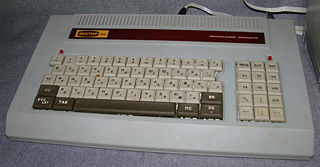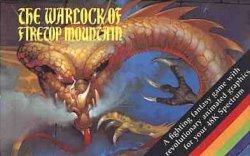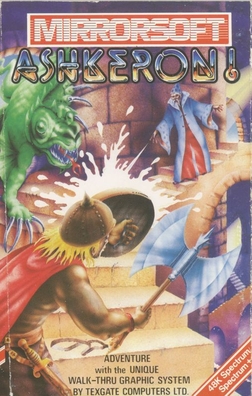Related Research Articles

The Jupiter Ace by Jupiter Cantab was a British home computer released in 1982. The Ace differed from other microcomputers of the time in that its programming environment used Forth instead of the more popular BASIC. This difference, along with limited available software and poor character based graphic display, limited sales and the machine was not a success.
The Sinclair QL is a personal computer launched by Sinclair Research in 1984, as an upper-end counterpart to the ZX Spectrum.

The ZX Spectrum is an 8-bit home computer developed and marketed by Sinclair Research. It has been considered as one of the most influential computers ever made, and is also one of the best selling computers ever, with over five million units sold. It was first released in the United Kingdom on 23 April 1982, and around the world in the following years, most notably in Europe, the United States, and Eastern Bloc countries.
BBC BASIC is an interpreted version of the BASIC programming language. It was developed by Acorn Computers Ltd when they were selected by the BBC to supply the computer for their BBC Literacy Project in 1981.
Sinclair BASIC is a dialect of the programming language BASIC used in the 8-bit home computers from Sinclair Research, Timex Sinclair and Amstrad. The Sinclair BASIC interpreter was written by Nine Tiles Networks Ltd.

The Micro-Professor MPF-I is a microcomputer released by Multitech in 1981. The company's first branded product, it was marketed as a training system to learn machine code and assembly language for the Zilog Z80 microprocessor. After releasing several iterations of the product, Acer sold the product line to Flite Electronics in 1993.

Hobbit is a Soviet/Russian 8-bit home computer, based on the ZX Spectrum hardware architecture. Besides Sinclair BASIC it also featured CP/M, Forth or LOGO modes, with the Forth or LOGO operating environment residing in an on-board ROM chip.

The Galaksija was a build-it-yourself computer designed by Voja Antonić. It was featured in the special edition Računari u vašoj kući of a popular eponymous science magazine, published late December 1983 in Belgrade, Yugoslavia. Kits were available but not required as it could be built entirely out of standard off-the-shelf parts. It was later also available in complete form.

3D Monster Maze is a survival horror computer game developed from an idea by J.K. Greye and programmed by Malcolm Evans and released in 1981 for the Sinclair ZX81 platform with the 16 KB memory expansion. The game was initially released by J. K. Greye Software in December 1981 and re-released in 1982 by Evans' own startup, New Generation Software. Rendered using low-resolution character block "graphics", it was one of the first 3D games for a home computer, and one of the first games incorporating typical elements of the genre that would later be termed survival horror.

Lenslok is a copy protection mechanism found in some computer games and other software on the Atari 8-bit computers, Commodore 64, ZX Spectrum, Sinclair QL, MSX and Amstrad CPC. It was created by John Frost, an inventor and electronics consultant, and marketed by ASAP Developments, a subsidiary of J Rothschild Holdings. The first game to use it was Elite for the ZX Spectrum.

Beta BASIC is a BASIC interpreter for the Sinclair Research ZX Spectrum microcomputer, written by Dr Andrew Wright in 1983 and sold by his one-man software house BetaSoft. BetaSoft also produced a regular newsletter/magazine, BetaNews.

Bug-Byte Software Ltd. was a video game company founded in 1980 in Liverpool, initially producing software for the Acorn Atom and ZX80. Bug-Byte's first hit was Don Priestley's Mazogs which was one of the most successful titles for the ZX81. In 1983, it published Manic Miner, considered to be one of the most influential platform games of all time. The company went into liquidation in 1985 but their name and logo were purchased by Argus Press PLC for use as a budget software label.
Crystal Computing, later renamed Design Design, was a British video game developer founded in 1982 by Chris Clarke and Ian Stamp while students at the University of Manchester. Graham Stafford, Neil Mottershead, Simon Brattel and Martin Horsley, joined the company as it expanded. The company's first software release was a compilation of games for the Sinclair ZX81, though it was with the ZX Spectrum that Crystal found its greatest success. A deal with the machine's manufacturer Sinclair to distribute Crystal's Zeus Assembler gave the company sufficient funds for a major marketing campaign for their next product, Halls of the Things, an arcade adventure game that became their most successful title.
The ZX Spectrum's software library was very diverse. While the majority of the software produced for the system was video games, others included programming language implementations, Sinclair BASIC extensions, databases, word processors, spread sheets, drawing and painting tools, and 3D modelling tools.

Vector-06C is a home computer with unique graphics capabilities that was designed and mass-produced in USSR in the late 1980s.

The Warlock of Firetop Mountain is an action game published by Crystal Computing in 1984 for the ZX Spectrum home computer. It is loosely based on the adventure gamebook of the same name written by Steve Jackson and Ian Livingstone, and published by Puffin Books in 1982.

Cosmic Guerilla is a fixed shooter arcade video game developed by Universal and released 1979. A ZX Spectrum port was published by Crystal Computing in 1983.

Sinclair Programs was a magazine published in the United Kingdom, initially by ECC Publications of London and subsequently by EMAP. It was originally dedicated entirely to listings for programs for the Sinclair Research ZX80, ZX81 and ZX Spectrum computers, contributed by readers. ZX80 listings no longer appeared after the May 1983 issue. Letters and software review pages were added in the March 1984 issue.

Mined-Out is a maze video game created by Ian Andrew originally for the ZX Spectrum home computer in 1983. The objective is to carefully navigate a series of grid-shaped minefields by moving from the bottom to the top of the screen. The number of invisible mines in spaces adjacent to the player's current position is shown but not their precise location, requiring deduction to advance past them and avoid getting blown up. Additional challenges are introduced in later stages.

Ashkeron! is an interactive fiction video game developed by Dorset-based Texgate Computers and published by Mirrorsoft for the Amstrad CPC and ZX Spectrum in 1985.
References
- ↑ "Six of the Best", ZX Computing, December–January 1983/84 issue(p.71), Argus Specialist Publications
- ↑ "Zeus Assembler review", Home Computing Weekly, issue 36 (p.52), Argus Specialist Publications, November 1983
- 1 2 3 4 5 "Zeus Assembler Review", Sinclair User , issue 15 (p.29), ECC Publications, June 1983
- 1 2 "New Companies on the Sinclair Bandwagon", Sinclair User, issue 21 (p.64), ECC Publications, December 1983
- 1 2 "Spectrum Assemblers and Monitors", Your Computer , Vol. 3, No. 5 (pp.54-55), IPC Business Press, May 1985
- 1 2 "The Extended Spectrum", Big K , issue 9 (pp.70-71), IPC Business Press, December 1984
- ↑ News, Home Computing Weekly, issue 29 (p.5), Argus Specialist Publications, September 1983